|
|
|
Sort Order |
|
|
|
Items / Page
|
|
|
|
|
|
|
| Srl | Item |
| 1 |
ID:
141535
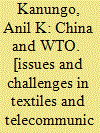

|
|
|
|
|
| Edition |
1st ed.
|
| Publication |
DelhI, Shipra Publications, 2015.
|
| Description |
x, 198p.hbk
|
| Standard Number |
9788175417946
|
|
|
|
|
|
|
|
|
|
|
|
Copies: C:1/I:0,R:0,Q:0
Circulation
| Accession# | Call# | Current Location | Status | Policy | Location |
| 058336 | 382.920951/KAN 058336 | Main | On Shelf | General | |
|
|
|
|
| 2 |
ID:
120215
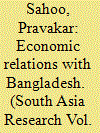

|
|
|
|
|
| Publication |
2013.
|
| Summary/Abstract |
Since 1971, India was the major trading partner of Bangladesh. However, China's trade with Bangladesh has increased manifold in recent years to surpass India from 2004 onwards. This slowing down and change of economic relations between India and Bangladesh, coupled with strained and uncertain political relations, raise multiple concerns. This article examines the various factors that have contributed to China's growing presence in Bangladesh as compared to India's decline with respect to trade and investment. India has clearly lost out to China in many important industries. While reviewing and assessing recent developments, the study also presents a strategy to counter India's declining economic influence in Bangladesh.
|
|
|
|
|
|
|
|
|
|
|
|
|
|
|
|
| 3 |
ID:
145996
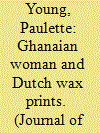

|
|
|
|
|
| Summary/Abstract |
This essay explores the role of textiles, particularly Dutch wax prints, in the lives of women in Ghana, West Africa. Wax prints are colorful message-bearing printed cloths produced in Holland, based on Indonesian batik designs that express meaningful messages. Central to this discussion is the practice of counter-appropriation, that is, how women as individuals are in dialogue with culture by transferring the foreign, in this case Dutch wax prints, into the local in a culturally appropriate way. It positions women not only as cloth distributors and consumers, but also as producers of knowledge through the phenomenon of naming.
|
|
|
|
|
|
|
|
|
|
|
|
|
|
|
|
| 4 |
ID:
184420
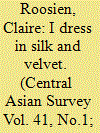

|
|
|
|
|
| Summary/Abstract |
In the 1930s, luxury textiles such as silk and velvet appeared frequently in agitation and propaganda addressed toward women in Uzbekistan. After examining the cultural and material significance of luxury textiles for Central Asian women before collectivization, this article investigates how luxury textiles were used in the effort to mobilize Central Asian women during the years of collectivization and cottonization (c.1929–37). The article concludes with a close reading of several ‘textile-texts’ produced by Central Asian women, focusing particularly on women’s poetry about luxury textiles. The article argues that the discourse of ‘silk and velvet’ tapped into affective resonances rooted in, among other conditions, the local gift economy, Central Asian women’s material conditions, Orientalist discourses and Stakhanovite propaganda. The discourse of silk and velvet thus bolstered hierarchical relations between Central Asian women and the Party–state, while at the same time it generated lateral ties to a public of other Central Asian women. The article relies on research in a variety of archival sources and the Uzbek-language Soviet press, particularly the women’s press.
|
|
|
|
|
|
|
|
|
|
|
|
|
|
|
|
| 5 |
ID:
123065
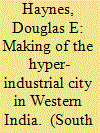

|
|
|
|
|
| Publication |
2013.
|
| Summary/Abstract |
This essay explores the rapid expansion of small handloom centres in Western India between 1930 and 1970. It attributes the transformation of these places into larger cities to the role of local weaver-capitalists, who developed new markets for local textiles and introduced significant technological innovations into the industry, and who forged strategies for combatting the growth of labour resistance. The essay also highlights the role of the late colonial and early post-Independence states, which promoted the growth of weavers' co-operatives and which imposed extensive regulations on larger enterprises. The paper argues that the powerloom centres of Western India sustained a 'hyper-industrial' quality, with limited economic or cultural diversification, restricted urban amenities and public services, and the extensive concentration of poor urban migrants in slums.
|
|
|
|
|
|
|
|
|
|
|
|
|
|
|
|
| 6 |
ID:
117806
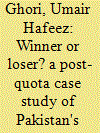

|
|
|
|
|
| Publication |
2012.
|
| Summary/Abstract |
Textiles and Clothing (T&C) is a critically important sector of international trade for developing countries and least developed countries (LDCs). The T&C sector engages abundant labour resources and requires low investment threshold. The T&C sector has been a contentious area in multilateral trade negotiations. With the expiration of quotas in 2005, many T&C dependent countries are experiencing considerable adjustment challenges. Pakistan is one such country that is extensively reliant on T&C industries. This research note presents a brief case study which looks at post-quota developments in Pakistan's T&C trade and the trade and economic policy issues it raises.
|
|
|
|
|
|
|
|
|
|
|
|
|
|
|
|
|
|
|
|
|